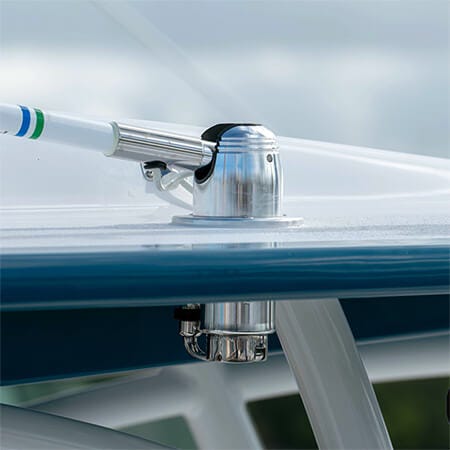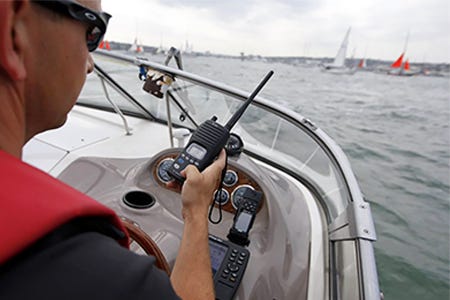

In most of the coastal waters of the United States a VHF marine radio is arguably the most important piece of safety equipment on your boat. Yes, EPIRBs and PLBs can transmit distress signals from anywhere in the world, but within about 20 miles of the U.S. coastline — and farther in many places — a properly used VHF radio will get you help faster, from fellow boaters and/or the Coast Guard or other responders. But the actual range of VHF radio depends in large part on the height of its antenna. Here’s why.
A Line-of-Sight Signal
The main reason VHF antenna height is so important is that VHF (very high frequency) radio is a “line-of-sight” signal, at least in theory. That means that if the tip of the transmitting antenna can’t “see” the tip of the receiving antenna with no obstructions in between (including the horizon), the receiving station won’t “hear” the transmission. Of course, that isn’t strictly true. Transmissions bounce around a good deal, and you can often hear them from much farther away than the “line-of-sight” rule would allow. But you should never count on more than line-of-sight.
Calculating the Theoretical Range
In open water and good conditions — in other words, with nothing but the curvature of the earth to get in the way — you can easily calculate the theoretical range of a VHF radio signal. One widely used formula for VHF range is to measure the height of the top of the antenna above the waterline, take the square root of that measurement, and multiply by 1.42.
Here’s a simple example. If you have an 8-foot antenna mounted on a T-top that is 8 feet above the water, your total height is 16 feet. Take the square root of 16 to get 4. Then multiply 4 times 1.42 to get about 5.7. So 5.7 miles is your theoretical range.
But remember, that’s only if the receiving station is right at water level. To find the distance at which two radios can communicate, you add the theoretical range of each together. So if you had two identical boats with antennas 16 feet above the water, they could communicate from 11.4 miles apart (5.7 miles plus 5.7 miles).
Other Factors Affecting VHF Range
Yes, other factors affect marine VHF range, including transmitter power (wattage), cable length and antenna gain, but antenna height is the single most important determining factor. A small 3-foot metal antenna on top of an 80’ sailboat mast will perform better than an 8-foot antenna with higher gain mounted on a powerboat tower 25 feet off the water.
Other factors affect marine VHF range, including transmitter power (wattage), cable length and antenna gain, but antenna height is the most important determining factor.
Understanding VHF Antenna Gain
Another important factor in VHF range is antenna "gain." Measured in decibels (dB), gain is the ability of an antenna to focus a signal in a horizontal plane (assuming the antenna is vertical). It’s important to understand that a higher gain antenna does not increase the transmission power of your radio; all fixed-mount marine VHF radios transmit at a maximum of 25 watts.
Instead, a higher gain antenna focuses or “flattens” the signal into something resembling a disk.
The higher the gain, the flatter the “disk.”
Although it’s not an exact comparison, imagine your radio signal as a flashlight beam.
A 3dB antenna produces a wide, diffuse, 160-degree beam, while a 9dB antenna produces a narrower, more “intense” 40-degree beam.
Antenna Performance
The "beam" in this analogy shines out at right angles from the antenna. The more narrowly focused flashlight beam can light up more distant objects than a wider beam, even though the total amount of light is the same.
Antennas function much the same way. For every increase of 3dB, the apparent power of the transmitter is doubled. In other words, to a receiving station, the same signal will “sound” twice as strong when transmitted through a 9dB antenna as when transmitted through a 6dB antenna.
The tradeoff with increased gain is that the more tightly focused “disk” pitches and rolls along with your boat — sort of like your headlight beams on a rough road. So, the signal from a 9dB antenna on a small boat in rough water may “fade” in and out for the receiving station. Realistically, 9dB antennas are practical only on large yachts and sportfishers.
To a receiving station, the same signal will “sound” twice as strong when transmitted through a 9dB antenna as when transmitted through a 6dB antenna.
On the other hand, most boats that venture offshore at all should probably have a 6dB antenna. Nearly all 6dB antennas are 8 feet in length. For bay and inshore boats, 3-foot, 3dB antennas are fine. They’re also more economical and less obtrusive on small boats.
Real World VHF Radio Range
Theory is great, but reality often differs. Atmospheric conditions, sea state, installation quality and many other factors influence the real-world range of a VHF radio and antenna on any given day. Here are a few general guidelines though.
Always keep in mind that the range of a given radio and antenna isn’t what matters. Instead, what matters is the range of a given pair of radios and antennas. For example, you might have a 9dB antenna mounted 50 feet off the water on your 105-foot sportfisher with. But your real range depends a lot on the other station. If you’re trying to communicate with somebody treading water with a handheld radio, the range for that pair of stations might be 10 or 12 miles at best. But if you’re trying to communicate with another yacht with a tall, high-gain antenna, your range might be several times that.
Always keep in mind that the range of a given radio and antenna isn’t what matters. Instead, what matters is the range of a given pair of radios and antennas.
VHF Communication Insights
In open water and normal conditions, expect a range of 10 to perhaps 25 miles between two typical outboard fishing boats with 8-foot antennas mounted on the T-top, hardtop or flybridge. Smaller boats with a 3-foot antenna mounted to the windshield grab rail have significantly reduced range — something like 4 to 8 miles plus the range of the receiving station.
Handheld radios have zero (or less than zero) gain antennas and are typically held 3 to 7 feet above the waterline when in use. They’re also limited to 5 or 6 watts of transmit power, versus 25 watts for a fixed-mount unit.
Range is much less than that of most fixed radios. Range between two handheld radios 6 feet above the waterline is roughly 1 to 4 miles.
You can contact the Coast Guard from a much greater range than you can contact other vessels, as Coast Guard VHF stations are installed on high towers or coastal mountaintops.
The Rescue 21 Distress System is designed to receive a signal from an antenna 6 feet above waterline from virtually anywhere within 20 nautical miles of the U.S. coast line.
The Rescue 21 Distress System is designed to receive a signal from a 1 watt transmitter with an antenna 6 feet above waterline from virtually anywhere within 20 nautical miles (23 statute miles) of the U.S. coast line. Boats with higher antennas transmitting at higher power should be able to communicate from significantly farther offshore.


